lock FIAT PUNTO 2012 Owner handbook (in English)
[x] Cancel search | Manufacturer: FIAT, Model Year: 2012, Model line: PUNTO, Model: FIAT PUNTO 2012Pages: 219, PDF Size: 9.58 MB
Page 154 of 219
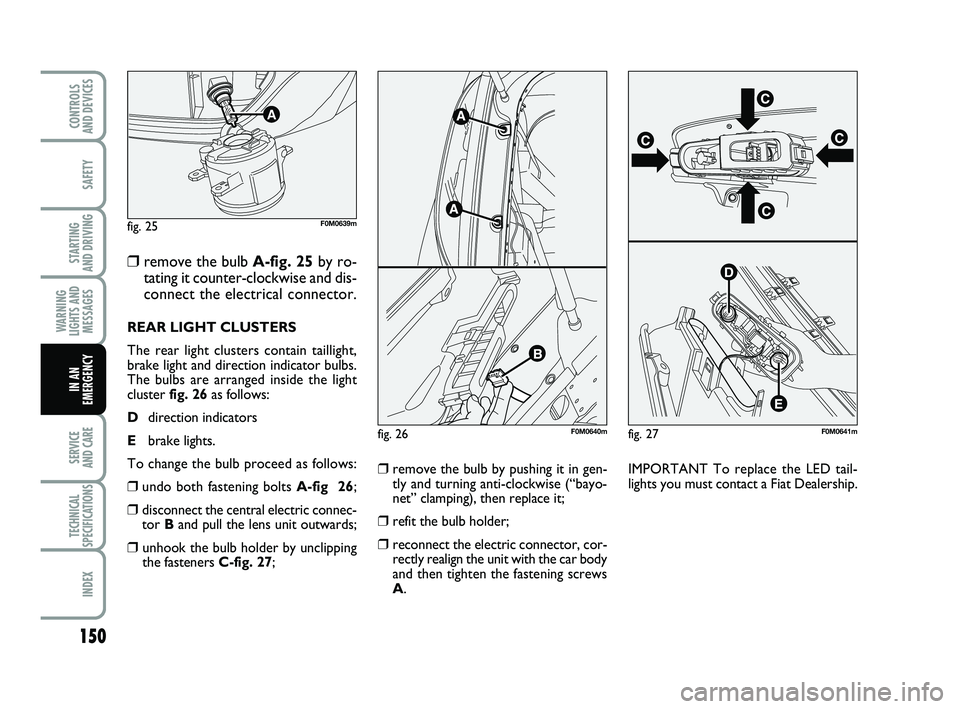
150
SAFETY
STARTING
AND DRIVING
WARNING
LIGHTS AND MESSAGES
SERVICE
AND CARE
TECHNICAL
SPECIFICATIONS
INDEX
CONTROLS
AND DEVICES
IN AN
EMERGENCY
❒remove the bulb A-fig. 25 by ro-
tating it counter-clockwise and dis-
connect the electrical connector.
REAR LIGHT CLUSTERS
The rear light clusters contain taillight,
brake light and direction indicator bulbs.
The bulbs are arranged inside the light
cluster fig. 26 as follows:
D direction indicators
E brake lights.
To change the bulb proceed as follows:
❒undo both fastening bolts A-fig 26;
❒disconnect the central electric connec-
tor Band pull the lens unit outwards;
❒ unhook the bulb holder by unclipping
the fasteners C-fig. 27;
❒remove the bulb by pushing it in gen-
tly and turning anti-clockwise (“bayo-
net” clamping), then replace it;
❒refit the bulb holder;
❒reconnect the electric connector, cor-
rectly realign the unit with the car body
and then tighten the fastening screws
A. IMPORTANT To replace the LED tail-
lights you must contact a Fiat Dealership.
fig. 25
A
F0M0639m
fig. 26F0M0640mfig. 27F0M0641m
133-164 PUNTO POP 1ed EN 30-09-2011 10:20 Pagina 150
Page 156 of 219
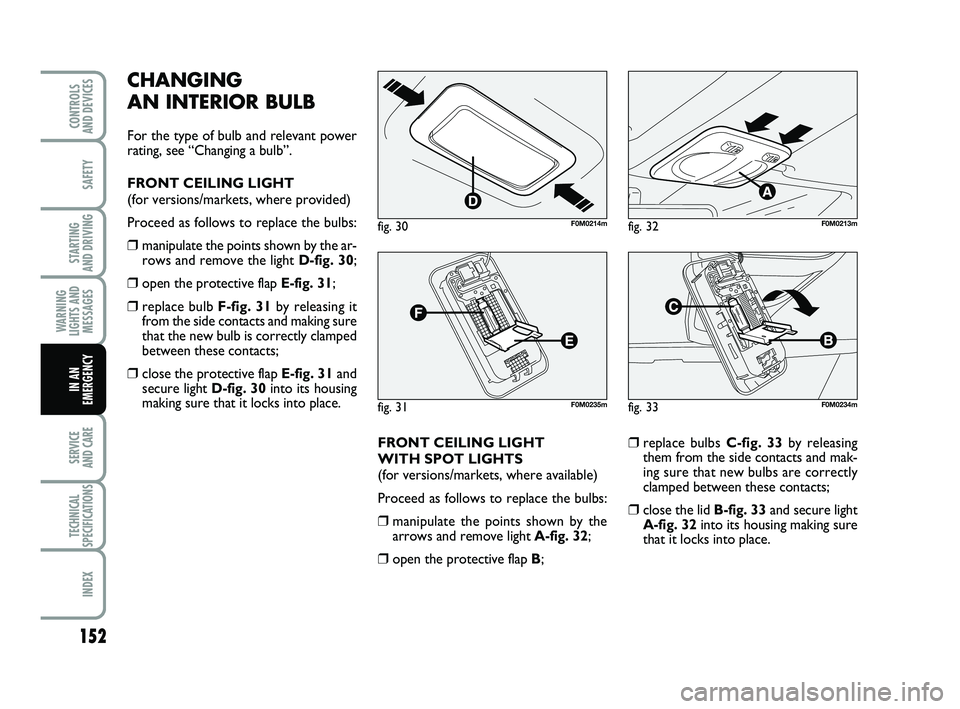
152
SAFETY
STARTING
AND DRIVING
WARNING
LIGHTS AND MESSAGES
SERVICE
AND CARE
TECHNICAL
SPECIFICATIONS
INDEX
CONTROLS
AND DEVICES
IN AN
EMERGENCY
CHANGING
AN INTERIOR BULB
For the type of bulb and relevant power
rating, see “Changing a bulb”.
FRONT CEILING LIGHT
(for versions/markets, where provided)
Proceed as follows to replace the bulbs:
❒manipulate the points shown by the ar-
rows and remove the light D-fig. 30 ;
❒open the protective flap E-fig. 31;
❒replace bulb F-fig. 31by releasing it
from the side contacts and making sure
that the new bulb is correctly clamped
between these contacts;
❒close the protective flap E-fig. 31and
secure light D-fig. 30 into its housing
making sure that it locks into place.
FRONT CEILING LIGHT
WITH SPOT LIGHTS
(for versions/markets, where available)
Proceed as follows to replace the bulbs:
❒manipulate the points shown by the
arrows and remove light A-fig. 32;
❒open the protective flap B;
❒replace bulbs C-fig. 33 by releasing
them from the side contacts and mak-
ing sure that new bulbs are correctly
clamped between these contacts;
❒close the lid B-fig. 33 and secure light
A-fig. 32 into its housing making sure
that it locks into place.
fig. 32F0M0213m
fig. 33F0M0234m
fig. 30F0M0214m
fig. 31F0M0235m
133-164 PUNTO POP 1ed EN 30-09-2011 10:20 Pagina 152
Page 161 of 219
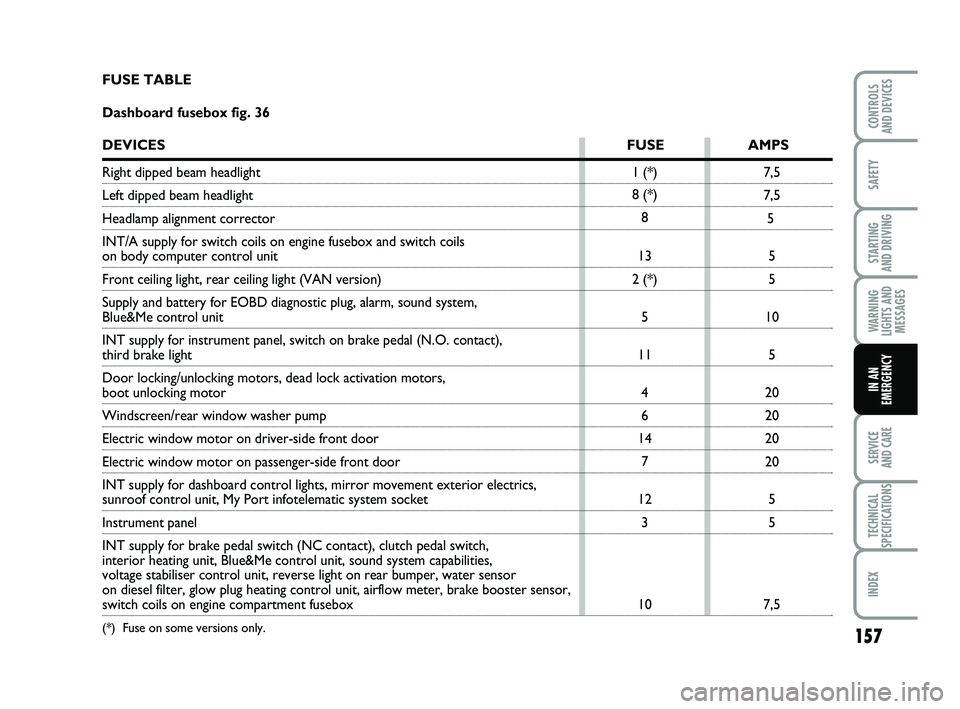
157
SAFETY
STARTING
AND DRIVING
WARNING
LIGHTS AND MESSAGES
SERVICE
AND CARE
TECHNICAL
SPECIFICATIONS
INDEX
CONTROLS
AND DEVICES
IN AN
EMERGENCY
1 (*)
8 (*)
8
13
2 (*)
5
11 4
6
14 7
12 3
10 7,5
7,5
5
5
5
10 5
20
20
20
20 5
5
7,5
FUSE TABLE
Dashboard fusebox fig. 36
DEVICES
FUSEAMPS
Right dipped beam headlight
Left dipped beam headlight
Headlamp alignment corrector
INT/A supply for switch coils on engine fusebox and switch coils
on body computer control unit
Front ceiling light, rear ceiling light (VAN version)
Supply and battery for EOBD diagnostic plug, alarm, sound system,
Blue&Me control unit
INT supply for instrument panel, switch on brake pedal (N.O. contact),\
third brake light
Door locking/unlocking motors, dead lock activation motors,
boot unlocking motor
Windscreen/rear window washer pump
Electric window motor on driver-side front door
Electric window motor on passenger-side front door
INT supply for dashboard control lights, mirror movement exterior electr\
ics,
sunroof control unit, My Port infotelematic system socket
Instrument panel
INT supply for brake pedal switch (NC contact), clutch pedal switch,
interior heating unit, Blue&Me control unit, sound system capabilities, \
voltage stabiliser control unit, reverse light on rear bumper, water sen\
sor
on diesel filter, glow plug heating control unit, airflow meter, brake b\
ooster sensor,
switch coils on engine compartment fusebox
(*) Fuse on some versions only.
133-164 PUNTO POP 1ed EN 30-09-2011 10:20 Pagina 157
Page 168 of 219
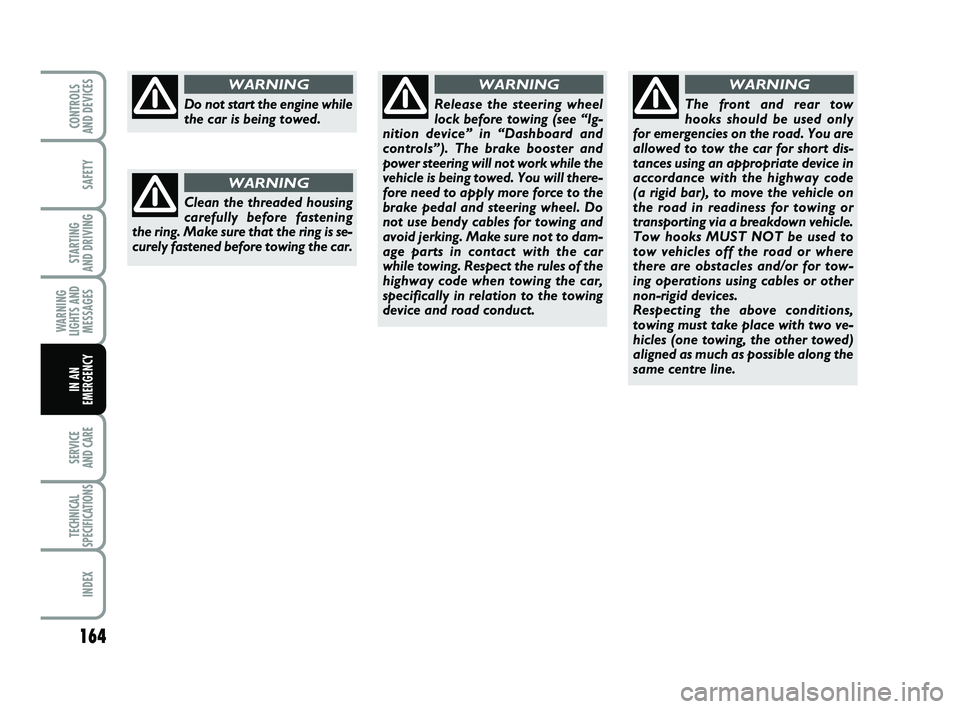
164
SAFETY
STARTING
AND DRIVING
WARNING
LIGHTS AND MESSAGES
SERVICE
AND CARE
TECHNICAL
SPECIFICATIONS
INDEX
CONTROLS
AND DEVICES
IN AN
EMERGENCY
Do not start the engine while
the car is being towed.
WARNING
Clean the threaded housing
carefully before fastening
the ring. Make sure that the ring is se-
curely fastened before towing the car.
WARNING
Release the steering wheel
lock before towing (see “Ig-
nition device” in “Dashboard and
controls”). The brake booster and
power steering will not work while the
vehicle is being towed. You will there-
fore need to apply more force to the
brake pedal and steering wheel. Do
not use bendy cables for towing and
avoid jerking. Make sure not to dam-
age parts in contact with the car
while towing. Respect the rules of the
highway code when towing the car,
specifically in relation to the towing
device and road conduct.
WARNING
The front and rear tow
hooks should be used only
for emergencies on the road. You are
allowed to tow the car for short dis-
tances using an appropriate device in
accordance with the highway code
(a rigid bar), to move the vehicle on
the road in readiness for towing or
transporting via a breakdown vehicle.
Tow hooks MUST NOT be used to
tow vehicles off the road or where
there are obstacles and/or for tow-
ing operations using cables or other
non-rigid devices.
Respecting the above conditions,
towing must take place with two ve-
hicles (one towing, the other towed)
aligned as much as possible along the
same centre line.
WARNING
133-164 PUNTO POP 1ed EN 30-09-2011 10:20 Pagina 164
Page 171 of 219
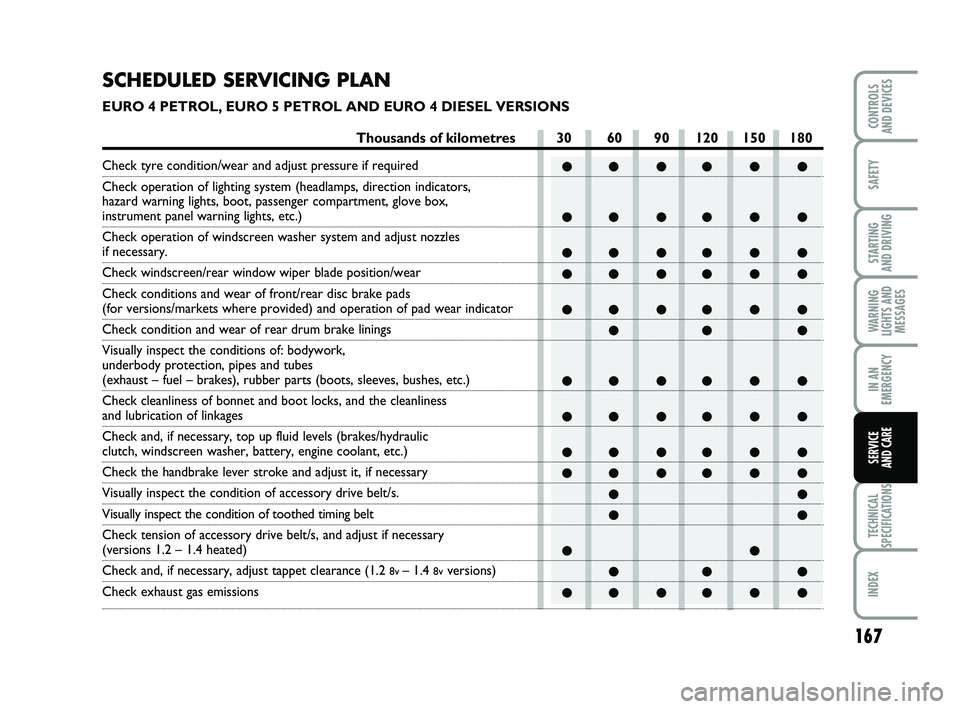
167
SAFETY
STARTING
AND DRIVING
WARNING
LIGHTS AND MESSAGES
IN AN
EMERGENCY
TECHNICAL
SPECIFICATIONS
INDEX
CONTROLS
AND DEVICES
SERVICE
AND CARE
●● ●● ● ●
●● ●● ● ●
●● ●● ● ●
●● ●● ● ●
●● ●● ● ●
●● ●
●● ●● ● ●
●● ●● ● ●
●● ●● ● ●
●● ●● ● ● ●●
●●
●● ●● ●
●● ●● ● ●
SCHEDULED SERVICING PLAN
EURO 4 PETROL, EURO 5 PETROL AND EURO 4 DIESEL VERSIONS
Thousands of kilometres 30 60 90 120 150 180
Check tyre condition/wear and adjust pressure if required
Check operation of lighting system (headlamps, direction indicators,
hazard warning lights, boot, passenger compartment, glove box,
instrument panel warning lights, etc.)
Check operation of windscreen washer system and adjust nozzles
if necessary.
Check windscreen/rear window wiper blade position/wear
Check conditions and wear of front/rear disc brake pads
(for versions/markets where provided) and operation of pad wear indica\
tor
Check condition and wear of rear drum brake linings
Visually inspect the conditions of: bodywork,
underbody protection, pipes and tubes
(exhaust – fuel – brakes), rubber parts (boots, sleeves, bushes, etc.)
Check cleanliness of bonnet and boot locks, and the cleanliness
and lubrication of linkages
Check and, if necessary, top up fluid levels (brakes/hydraulic
clutch, windscreen washer, battery, engine coolant, etc.)
Check the handbrake lever stroke and adjust it, if necessary
Visually inspect the condition of accessory drive belt/s.
Visually inspect the condition of toothed timing belt
Check tension of accessory drive belt/s, and adjust if necessary
(versions 1.2 – 1.4 heated)
Check and, if necessary, adjust tappet clearance (1.2 8v – 1.4 8vversions)
Check exhaust gas emissions
165-184 PUNTO POP 1ed EN 30-09-2011 10:21 Pagina 167
Page 173 of 219
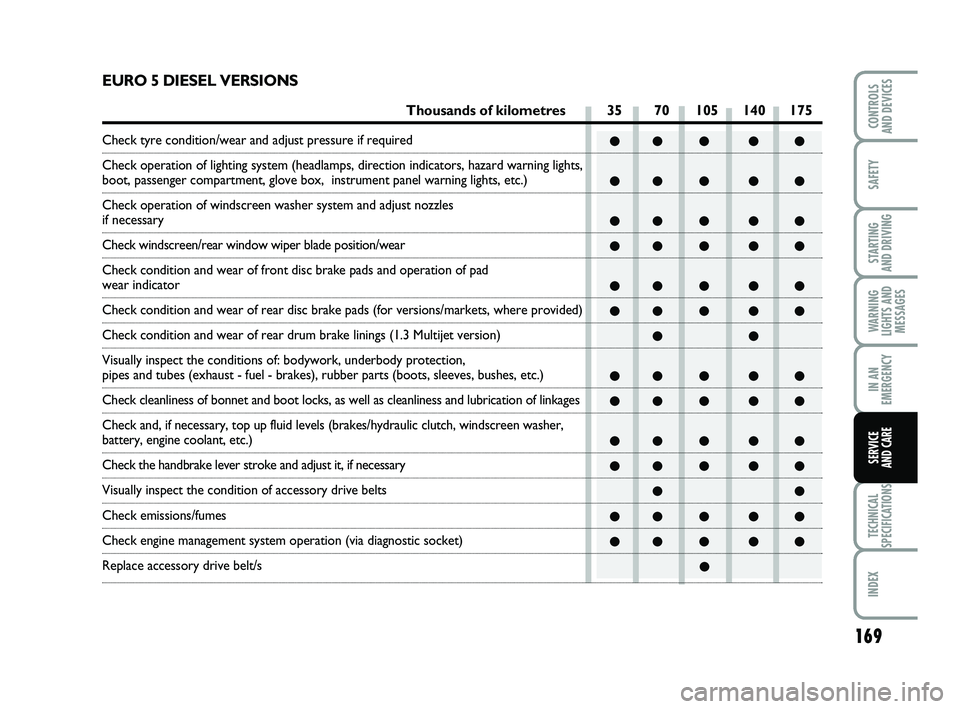
169
SAFETY
STARTING
AND DRIVING
WARNING
LIGHTS AND MESSAGES
IN AN
EMERGENCY
TECHNICAL
SPECIFICATIONS
INDEX
CONTROLS
AND DEVICES
SERVICE
AND CARE
●● ● ● ●
●● ● ● ●
●● ● ● ●
●● ● ● ●
●● ● ● ●
●● ● ● ●
●●
●● ● ● ●
●● ● ● ●
●● ● ● ●
●● ● ● ● ●●
●● ● ● ●
●● ● ● ● ●
EURO 5 DIESEL VERSIONS
Thousands of kilometres 35 70 105 140 175
Check tyre condition/wear and adjust pressure if required
Check operation of lighting system (headlamps, direction indicators, ha\
zard warning lights,
boot, passenger compartment, glove box, instrument panel warning lights\
, etc.)
Check operation of windscreen washer system and adjust nozzles
if necessary
Check windscreen/rear window wiper blade position/wear
Check condition and wear of front disc brake pads and operation of pad
wear indicator
Check condition and wear of rear disc brake pads (for versions/markets,\
where provided)
Check condition and wear of rear drum brake linings (1.3 Multijet versi\
on)
Visually inspect the conditions of: bodywork, underbody protection,
pipes and tubes (exhaust - fuel - brakes), rubber parts (boots, sleev\
es, bushes, etc.)
Check cleanliness of bonnet and boot locks, as well as cleanliness and l\
ubrication of linkages
Check and, if necessary, top up fluid levels (brakes/hydraulic clutch, \
windscreen washer,
battery, engine coolant, etc.)
Check the handbrake lever stroke and adjust it, if necessary
Visually inspect the condition of accessory drive belts
Check emissions/fumes
Check engine management system operation (via diagnostic socket)
Replace accessory drive belt/s
165-184 PUNTO POP 1ed EN 30-09-2011 10:21 Pagina 169
Page 175 of 219
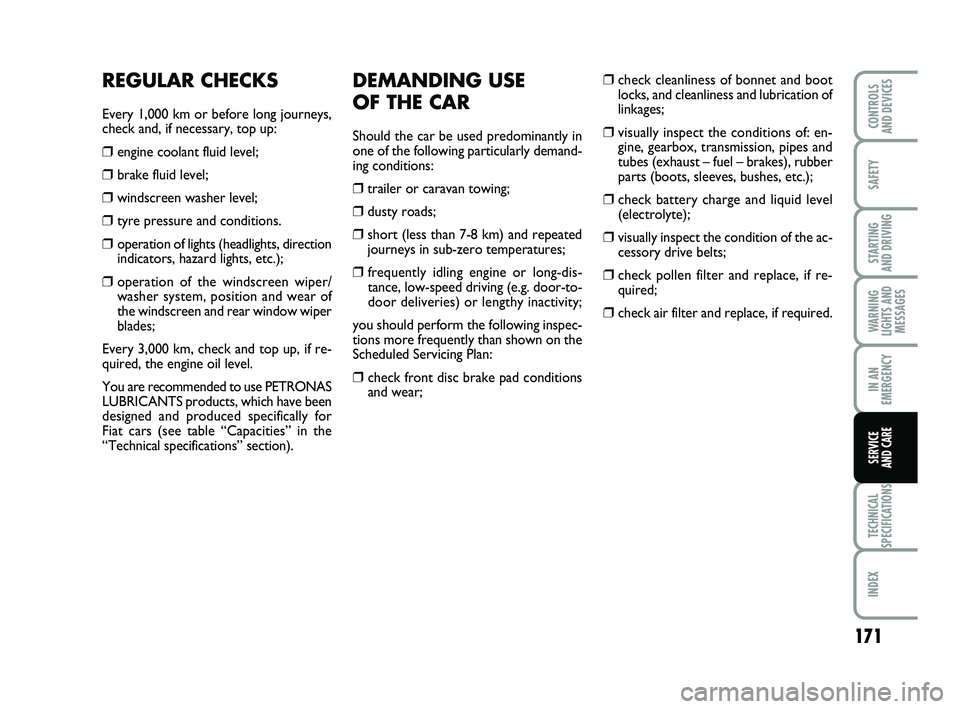
171
SAFETY
STARTING
AND DRIVING
WARNING
LIGHTS AND MESSAGES
IN AN
EMERGENCY
TECHNICAL
SPECIFICATIONS
INDEX
CONTROLS
AND DEVICES
SERVICE
AND CARE
DEMANDING USE
OF THE CAR
Should the car be used predominantly in
one of the following particularly demand-
ing conditions:
❒trailer or caravan towing;
❒dusty roads;
❒short (less than 7-8 km) and repeated
journeys in sub-zero temperatures;
❒ frequently idling engine or long-dis-
tance, low-speed driving (e.g. door-to-
door deliveries) or lengthy inactivity;
you should perform the following inspec-
tions more frequently than shown on the
Scheduled Servicing Plan:
❒ check front disc brake pad conditions
and wear;
❒check cleanliness of bonnet and boot
locks, and cleanliness and lubrication of
linkages;
❒ visually inspect the conditions of: en-
gine, gearbox, transmission, pipes and
tubes (exhaust – fuel – brakes), rubber
parts (boots, sleeves, bushes, etc.);
❒check battery charge and liquid level
(electrolyte);
❒visually inspect the condition of the ac-
cessory drive belts;
❒check pollen filter and replace, if re-
quired;
❒check air filter and replace, if required.
REGULAR CHECKS
Every 1,000 km or before long journeys,
check and, if necessary, top up:
❒engine coolant fluid level;
❒brake fluid level;
❒windscreen washer level;
❒tyre pressure and conditions.
❒operation of lights (headlights, direction
indicators, hazard lights, etc.);
❒operation of the windscreen wiper/
washer system, position and wear of
the windscreen and rear window wiper
blades;
Every 3,000 km, check and top up, if re-
quired, the engine oil level.
You are recommended to use PETRONAS
LUBRICANTS products, which have been
designed and produced specifically for
Fiat cars (see table “Capacities” in the
“Technical specifications” section).
165-184 PUNTO POP 1ed EN 30-09-2011 10:21 Pagina 171
Page 185 of 219
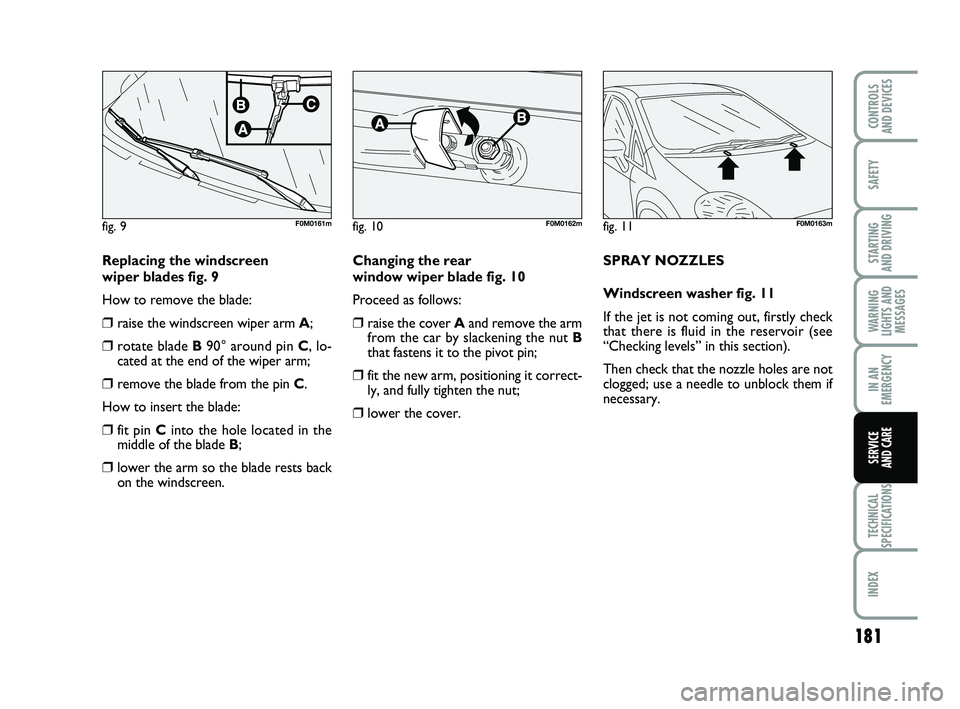
181
SAFETY
STARTING
AND DRIVING
WARNING
LIGHTS AND MESSAGES
IN AN
EMERGENCY
TECHNICAL
SPECIFICATIONS
INDEX
CONTROLS
AND DEVICES
SERVICE
AND CARE
Replacing the windscreen
wiper blades fig. 9
How to remove the blade:
❒raise the windscreen wiper arm A;
❒rotate blade B90° around pin C , lo-
cated at the end of the wiper arm;
❒remove the blade from the pin C.
How to insert the blade:
❒fit pin C into the hole located in the
middle of the blade B;
❒lower the arm so the blade rests back
on the windscreen.
fig. 9F0M0161m
Changing the rear
window wiper blade fig. 10
Proceed as follows:
❒raise the cover A and remove the arm
from the car by slackening the nut B
that fastens it to the pivot pin;
❒fit the new arm, positioning it correct-
ly, and fully tighten the nut;
❒lower the cover.
fig. 10F0M0162m
SPRAY NOZZLES
Windscreen washer fig. 11
If the jet is not coming out, firstly check
that there is fluid in the reservoir (see
“Checking levels” in this section).
Then check that the nozzle holes are not
clogged; use a needle to unblock them if
necessary.
fig. 11F0M0163m
165-184 PUNTO POP 1ed EN 30-09-2011 10:21 Pagina 181
Page 188 of 219
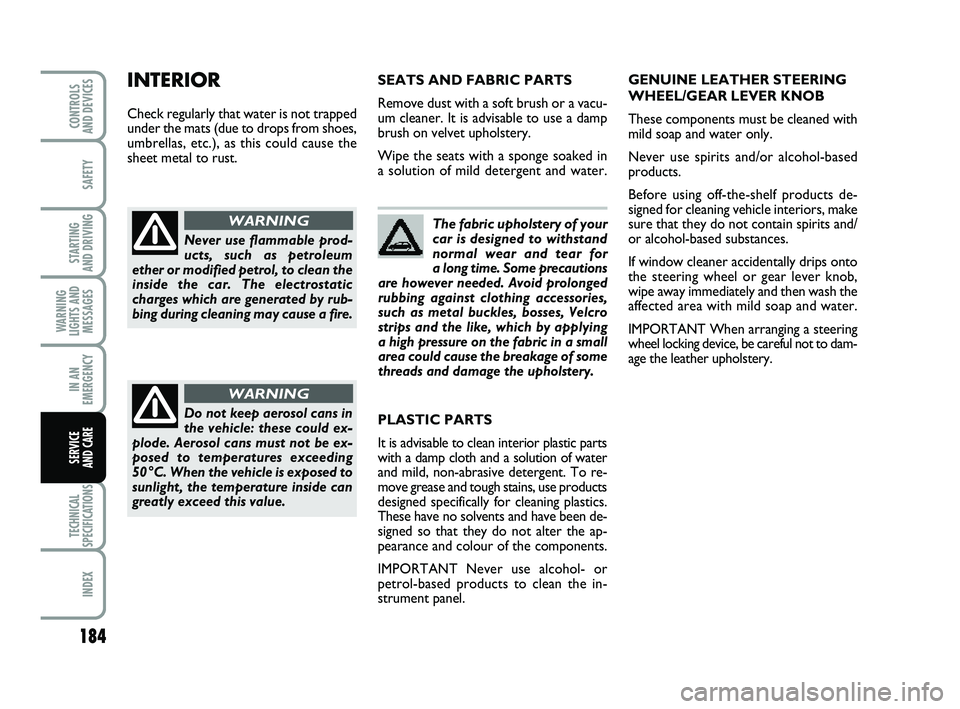
184
SAFETY
STARTING
AND DRIVING
WARNING
LIGHTS AND MESSAGES
IN AN
EMERGENCY
TECHNICAL
SPECIFICATIONS
INDEX
CONTROLS
AND DEVICES
SERVICE
AND CARE
The fabric upholstery of your
car is designed to withstand
normal wear and tear for
a long time. Some precautions
are however needed. Avoid prolonged
rubbing against clothing accessories,
such as metal buckles, bosses, Velcro
strips and the like, which by applying
a high pressure on the fabric in a small
area could cause the breakage of some
threads and damage the upholstery.
SEATS AND FABRIC PARTS
Remove dust with a soft brush or a vacu-
um cleaner. It is advisable to use a damp
brush on velvet upholstery.
Wipe the seats with a sponge soaked in
a solution of mild detergent and water.
Never use flammable prod-
ucts, such as petroleum
ether or modified petrol, to clean the
inside the car. The electrostatic
charges which are generated by rub-
bing during cleaning may cause a fire.
WARNING
Do not keep aerosol cans in
the vehicle: these could ex-
plode. Aerosol cans must not be ex-
posed to temperatures exceeding
50 °C. When the vehicle is exposed to
sunlight, the temperature inside can
greatly exceed this value.
WARNING
INTERIOR
Check regularly that water is not trapped
under the mats (due to drops from shoes,
umbrellas, etc.), as this could cause the
sheet metal to rust. GENUINE LEATHER STEERING
WHEEL/GEAR LEVER KNOB
These components must be cleaned with
mild soap and water only.
Never use spirits and/or alcohol-based
products.
Before using off-the-shelf products de-
signed for cleaning vehicle interiors, make
sure that they do not contain spirits and/
or alcohol-based substances.
If window cleaner accidentally drips onto
the steering wheel or gear lever knob,
wipe away immediately and then wash the
affected area with mild soap and water.
IMPORTANT When arranging a steering
wheel locking device, be careful not to dam-
age the leather upholstery.
PLASTIC PARTS
It is advisable to clean interior plastic parts
with a damp cloth and a solution of water
and mild, non-abrasive detergent. To re-
move grease and tough stains, use products
designed specifically for cleaning plastics.
These have no solvents and have been de-
signed so that they do not alter the ap-
pearance and colour of the components.
IMPORTANT Never use alcohol- or
petrol-based products to clean the in-
strument panel.
165-184 PUNTO POP 1ed EN 30-09-2011 10:21 Pagina 184
Page 191 of 219
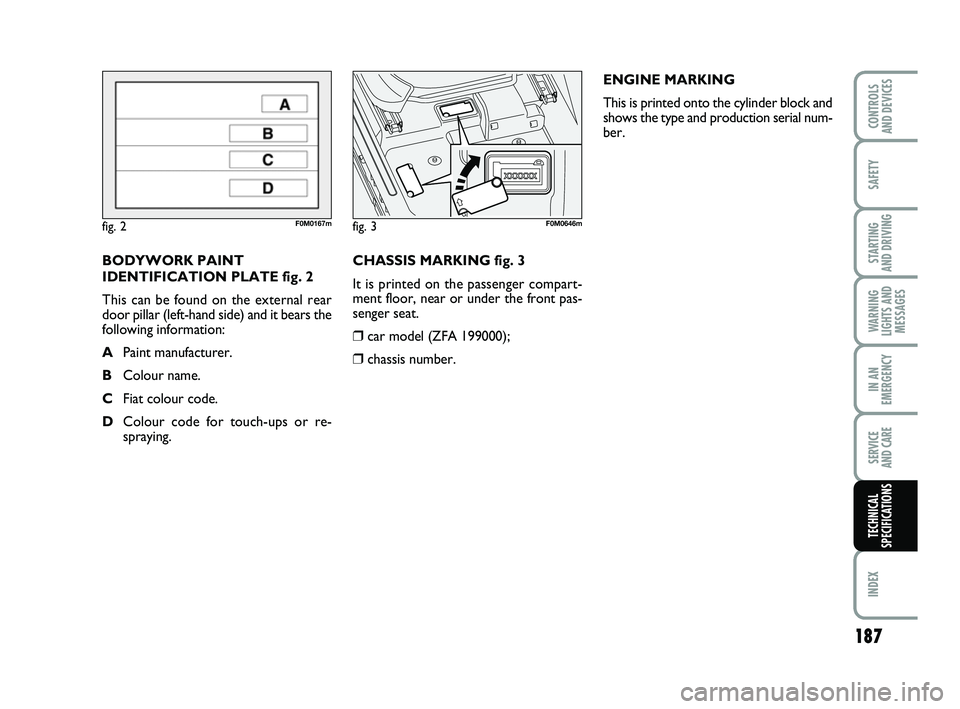
187
SAFETY
STARTING
AND DRIVING
WARNING
LIGHTS AND MESSAGES
IN AN
EMERGENCY
SERVICE
AND CARE
INDEX
CONTROLS
AND DEVICES
TECHNICAL
SPECIFICATIONS
CHASSIS MARKING fig. 3
It is printed on the passenger compart-
ment floor, near or under the front pas-
senger seat.
❒car model (ZFA 199000);
❒chassis number. ENGINE MARKING
This is printed onto the cylinder block and
shows the type and production serial num-
ber.
BODYWORK PAINT
IDENTIFICATION PLATE fig. 2
This can be found on the external rear
door pillar (left-hand side) and it bears the
following information:
A Paint manufacturer.
B Colour name.
C Fiat colour code.
D Colour code for touch-ups or re-
spraying.
fig. 2F0M0167mfig. 3F0M0646m
185-208 PUNTO POP 1ed EN 3-10-2011 11:50 Pagina 187